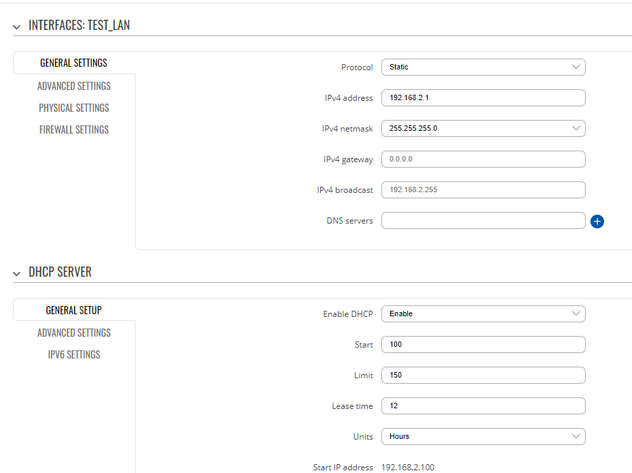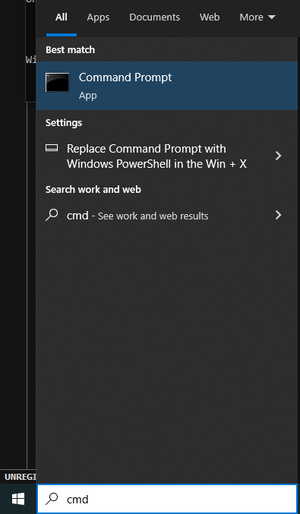VLAN Set Up: Difference between revisions
No edit summary |
No edit summary |
||
| Line 1: | Line 1: | ||
== Introduction == | == Introduction == | ||
This article contains instructions o how to set up VLAN using a Teltonika-Networks device. | This article contains instructions o how to set up VLAN using a Teltonika-Networks device. Following this example, you will be able to create two different networks (network interfaces) and limit speed on one of the interfaces (or both of them). | ||
For this example I will be using RUTX11 device. | For this example, I will be using the RUTX11 device. | ||
== Creating VLAN == | == Creating VLAN == | ||
To create VLAN | To create a VLAN follow all the steps below: | ||
* Access your | * Access your device WebUI by typing your Routers Private or Public IP in your browser (my router has private IP 192.168.1.1) | ||
* Next navigate to | * Next, navigate to '''Network → Vlan → Port Based''' | ||
* Now you'll need to add new VLAN and change first VLAN ('''ID:1''') configuration. So basically you need to choose | * Now you'll need to add a new VLAN and change the first VLAN ('''ID:1''') configuration. So basically you need to choose which port you will use for yourself and turn that port Off in VLAN ('''ID:1'''). In my example, I've chosen a second Ethernet port for myself. | ||
I've turned '''off''' in first '''VLAN's LAN 2''' port and in my new '''VLAN 3''' I've turned '''on''' (by choosing '''Untagged''') '''LAN2''' port: | I've turned '''off''' in first '''VLAN's LAN 2''' port and in my new '''VLAN 3''' I've turned '''on''' (by choosing '''Untagged''') the '''LAN2''' port: | ||
[[File:Vlan1.png|thumb|alt=|center|824x824px]] | [[File:Vlan1.png|thumb|alt=|center|824x824px]] | ||
| Line 19: | Line 19: | ||
==Creating Interface's== | ==Creating Interface's== | ||
*Now navigate to '''Network | *Now navigate to '''Network → Interfaces''' | ||
*Add a new instance, by entering any interface name and pressing '''ADD''' button: | *Add a new instance, by entering any interface name and pressing '''ADD''' button: | ||
[[File:Vlan2.png|center|thumb|948x948px]] | [[File:Vlan2.png|center|thumb|948x948px]] | ||
| Line 25: | Line 25: | ||
*Now a new window for your interface configuration will pop up: | *Now a new window for your interface configuration will pop up: | ||
*#For protocol select "'''Static'''" | *#For protocol select "'''Static'''" | ||
*#For IPv4 type IP of your choice with different subnet. For example if you are using default router configurations your device should have IP: '''192.168.1.1''' and netmask: '''255.255.255.0''', for this example we can change only one number, type: '''192.168.2.1''' | *#For IPv4 type IP of your choice with a different subnet. For example, if you are using default router configurations your device should have IP: '''192.168.1.1''' and netmask: '''255.255.255.0''', for this example we can change only one number, type: '''192.168.2.1''' | ||
*#For Netmask you can leave it default: '''255.255.255.0''' | *#For Netmask, you can leave it default: '''255.255.255.0''' | ||
*#Press the button "'''SETUP DHCP SERVER'''" | *#Press the button "'''SETUP DHCP SERVER'''" | ||
*#And leave everything else default, your configuration should look like this: | *#And leave everything else default, your configuration should look like this: | ||
| Line 32: | Line 32: | ||
[[File:Vlan3.png|center|thumb|632x632px]] | [[File:Vlan3.png|center|thumb|632x632px]] | ||
*Next go to the "'''PHYSICAL SETTINGS'''" | *Next, go to the "'''PHYSICAL SETTINGS'''" | ||
*Select your newly created VLAN in Interface drop-down (it should be named '''eth0.3'''): | *Select your newly created VLAN in the Interface drop-down (it should be named '''eth0.3'''): | ||
[[File:Vlan4.png|center|thumb|761x761px]] | [[File:Vlan4.png|center|thumb|761x761px]] | ||
*Press "'''SAVE & APPLY'''" button | *Press "the '''SAVE & APPLY'''" button | ||
*If you've configurated everything correctly your new Interface should be running like in my case: | *If you've configurated everything correctly your new Interface should be running like in my case: | ||
| Line 44: | Line 44: | ||
==Testing new VLAN== | ==Testing new VLAN== | ||
Now by plugging my PC | Now by plugging my PC into the Ethernet cable with the RUTX11 LAN2 port you need to check if everything is working correctly. To do that you'll need: | ||
*On your Windows machine open '''CMD''' (you can do it by typing in Windows search "'''CMD'''" and press '''Enter'''): | *On your Windows machine open '''CMD''' (you can do it by typing in Windows search "'''CMD'''" and press '''Enter'''): | ||
| Line 50: | Line 50: | ||
[[File:Vlan6.png|center|thumb]] | [[File:Vlan6.png|center|thumb]] | ||
*In CMD type command "'''ipconfig'''", press '''Enter''' and search for '''Ethernet adapter''' and check if you got '''IP''' address like I did ('''192.168.2.x'''): | *In CMD type the command "'''ipconfig'''", press '''Enter''' and search for '''Ethernet adapter''' and check if you got the '''IP''' address like I did ('''192.168.2.x'''): | ||
[[File:Vlan7.png|center|thumb|499x499px]] | [[File:Vlan7.png|center|thumb|499x499px]] | ||
If you did, then you've done everything correctly, if you didn't go | If you did, then you've done everything correctly, if you didn't go through all set up again and check if you have missed anything. | ||
==Setting up data limit on interface== | ==Setting up data limit on the interface== | ||
This step is optional, complete this if you need to limit internet data on one of your | This step is optional, complete this if you need to limit internet data on one of your interfaces (or both). | ||
You'll need to create '''QoS''' configuration, for this you'll need to download '''QoS''' package in '''Services | You'll need to create a '''QoS''' configuration, for this you'll need to download the '''QoS''' package in '''Services → Package Manager → Packages''' and limit the internet speed for an interface that you want to be limited. | ||
Note: If you set '''QoS''' for the '''LAN''' interface, the direction logic is naturally inverted. Egress means "from router towards '''LAN'''" = in practice "download from '''WAN''' forwarded to '''LAN'''". | Note: If you set '''QoS''' for the '''LAN''' interface, the direction logic is naturally inverted. Egress means "from router towards '''LAN'''" = in practice "download from '''WAN''' forwarded to '''LAN'''". | ||
For more detailed information about how to configure QoS and how it works, you can read it [https://wiki.teltonika-networks.com/view/RUTX11_Traffic_Shaping here]. | |||
[[Category:Networking]] | [[Category:Networking]] | ||
Revision as of 08:47, 20 April 2022
Main Page > FAQ > Networking > VLAN Set UpIntroduction
This article contains instructions o how to set up VLAN using a Teltonika-Networks device. Following this example, you will be able to create two different networks (network interfaces) and limit speed on one of the interfaces (or both of them).
For this example, I will be using the RUTX11 device.
Creating VLAN
To create a VLAN follow all the steps below:
- Access your device WebUI by typing your Routers Private or Public IP in your browser (my router has private IP 192.168.1.1)
- Next, navigate to Network → Vlan → Port Based
- Now you'll need to add a new VLAN and change the first VLAN (ID:1) configuration. So basically you need to choose which port you will use for yourself and turn that port Off in VLAN (ID:1). In my example, I've chosen a second Ethernet port for myself.
I've turned off in first VLAN's LAN 2 port and in my new VLAN 3 I've turned on (by choosing Untagged) the LAN2 port:

- Press Save & Apply
Creating Interface's
- Now navigate to Network → Interfaces
- Add a new instance, by entering any interface name and pressing ADD button:

- Now a new window for your interface configuration will pop up:
- For protocol select "Static"
- For IPv4 type IP of your choice with a different subnet. For example, if you are using default router configurations your device should have IP: 192.168.1.1 and netmask: 255.255.255.0, for this example we can change only one number, type: 192.168.2.1
- For Netmask, you can leave it default: 255.255.255.0
- Press the button "SETUP DHCP SERVER"
- And leave everything else default, your configuration should look like this:

- Next, go to the "PHYSICAL SETTINGS"
- Select your newly created VLAN in the Interface drop-down (it should be named eth0.3):

- Press "the SAVE & APPLY" button
- If you've configurated everything correctly your new Interface should be running like in my case:

Testing new VLAN
Now by plugging my PC into the Ethernet cable with the RUTX11 LAN2 port you need to check if everything is working correctly. To do that you'll need:
- On your Windows machine open CMD (you can do it by typing in Windows search "CMD" and press Enter):

- In CMD type the command "ipconfig", press Enter and search for Ethernet adapter and check if you got the IP address like I did (192.168.2.x):

If you did, then you've done everything correctly, if you didn't go through all set up again and check if you have missed anything.
Setting up data limit on the interface
This step is optional, complete this if you need to limit internet data on one of your interfaces (or both).
You'll need to create a QoS configuration, for this you'll need to download the QoS package in Services → Package Manager → Packages and limit the internet speed for an interface that you want to be limited.
Note: If you set QoS for the LAN interface, the direction logic is naturally inverted. Egress means "from router towards LAN" = in practice "download from WAN forwarded to LAN".
For more detailed information about how to configure QoS and how it works, you can read it here.
